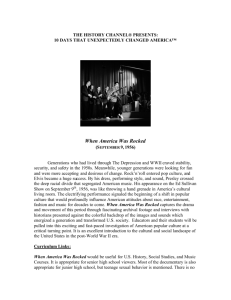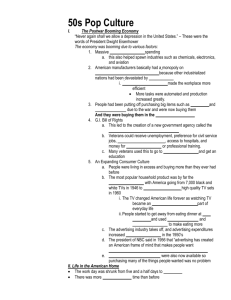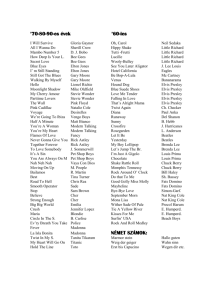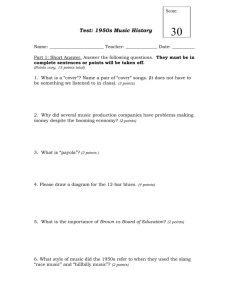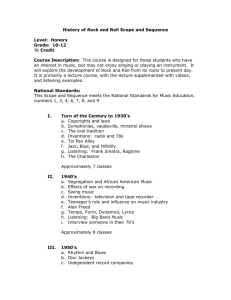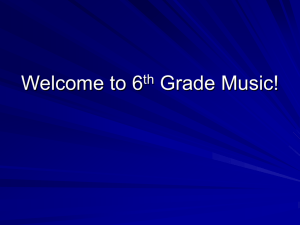Western Popular Music
advertisement
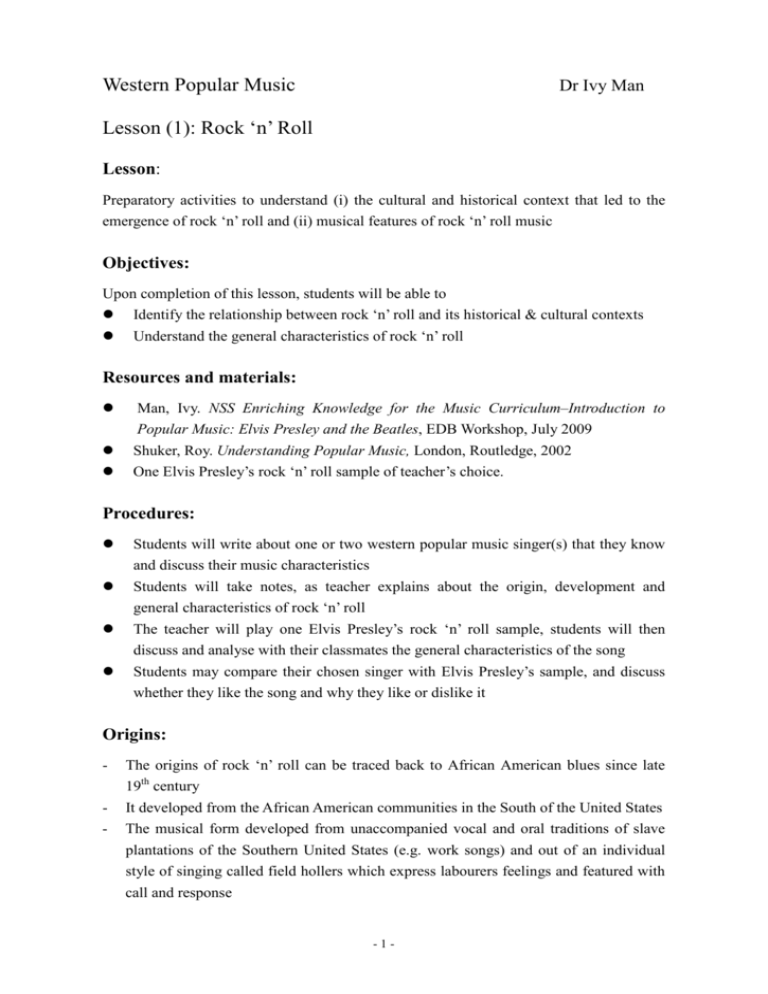
Western Popular Music Dr Ivy Man Lesson (1): Rock ‘n’ Roll Lesson: Preparatory activities to understand (i) the cultural and historical context that led to the emergence of rock ‘n’ roll and (ii) musical features of rock ‘n’ roll music Objectives: Upon completion of this lesson, students will be able to Identify the relationship between rock ‘n’ roll and its historical & cultural contexts Understand the general characteristics of rock ‘n’ roll Resources and materials: Man, Ivy. NSS Enriching Knowledge for the Music Curriculum–Introduction to Popular Music: Elvis Presley and the Beatles, EDB Workshop, July 2009 Shuker, Roy. Understanding Popular Music, London, Routledge, 2002 One Elvis Presley’s rock ‘n’ roll sample of teacher’s choice. Procedures: Students will write about one or two western popular music singer(s) that they know and discuss their music characteristics Students will take notes, as teacher explains about the origin, development and general characteristics of rock ‘n’ roll The teacher will play one Elvis Presley’s rock ‘n’ roll sample, students will then discuss and analyse with their classmates the general characteristics of the song Students may compare their chosen singer with Elvis Presley’s sample, and discuss whether they like the song and why they like or dislike it Origins: - The origins of rock ‘n’ roll can be traced back to African American blues since late 19th century It developed from the African American communities in the South of the United States The musical form developed from unaccompanied vocal and oral traditions of slave plantations of the Southern United States (e.g. work songs) and out of an individual style of singing called field hollers which express labourers feelings and featured with call and response -1- - - - And the transition from country to urban blues began in the 1920s had vastly been driven by the successive waves of economic crisis that associated with the Great Migration, i.e. pursuit of work and move of the rural Blacks to urban areas due to worsening social and economic conditions for African Americans in the South Urban blues were elaborated to adapt a large and different variety of audiences Boogie Woogie, a style associated with piano and solo singer, was an important blues style developed in Chicago since 1930s Chicago Blues, characterised with use of amplification, heavy and rough vocal timbre, electric guitar, bass, drums & sometimes piano as well as harmonica tremolos, became popular after WWII and the 1950s The term Rhythm and Blues (R & B), originally given by the white Americans to refer to recordings marketed predominantly to urban African Americans, was used to refer to music style that incorporated electric urban blues, strong backbeat and repeated variations on syncopated instrumental phrases Early rock ‘n’ roll: 50s to 60s - - - Rock ‘n’ roll was initially released by independent record companies It was disc jockey Alan Freed who first introduced R & B as rock ‘n’ roll to both the white and blacks listeners since early 50s Though Bill Haley’s ‘Rock Around the Clock’, first issued in 1954 and became the opening sequence of the film Blackboard Jungle in 1955, is not the first rock and roll record, his recording is widely considered to be the song that, more than any other, brought rock and roll to mainstream culture in the United States Rock Around the Clock http://www.youtube.com/watch?v=F5fsqYctXgM The song became one of the biggest hits in history and was the anthem of rebellious teenage culture in the 50s Bill Haley, one of the earliest white musician to bring rock and roll to the attention of white America, is crowned by the media as the Father of rock ‘n’ roll Other white singers such as Elvis Presley and Carl Perkins who played and recorded rock ‘n’ roll music also became famous since the mid-1950s The era of early rock ‘n’ roll in the United States had come to an end as major figures such as Elvis Presley departed for army service, Little Richard retired to become a preacher and DJ Alan Freed involved in a scandal As interest in rock and roll was beginning to decline in America in the late 1950s and early 1960s, it was taken up by groups in Britain The Beatles, for example, revived rock ‘n’ roll and had become an international success since 1964 -2- General musical features of early rock ‘n’ roll: - Early rock ‘n’ roll were based on 12-bar blues harmonic framework. It is reflected by a standard harmonic progression of twelve bars in quadruple meters. I I or IV I I IV IV I I V V or IV I I or V Table 1: 12-bar Blues Harmonic Framework: - Electric and bass guitars, drum kit, piano and saxophone are commonly used - It is often said that rock ‘n’ roll is “blues with a backbeat”. It usually featured an accentuated backbeat - Fast rhythmic drive is another noticeable feature Suggested Questions: 1. Define the following terms: work song, Boogie Woogie and Chicago Blues. 2. Briefly explain the origins of early rock ‘n’ roll music. 3. Name two rock ‘n’ roll singers in the 1950s. 4. Describe 12-bar blues harmonic framework. 5. What are the musical features of early rock ‘n’ roll? 6. What instruments are used in the (teacher’s) chosen sample? 7. To what extent do you like the chosen sample? Explain. -3- Lesson (2): Don’t be Cruel, Elvis Presley Objectives: Upon completion of this lesson, students will be able to Have an idea of who Elvis Presley is Understand the background of Elvis Presley’s ‘Don’t be Cruel’ Identify the characteristics of ‘Don’t be Cruel’ Resources and Materials: Don’t be Cruel: http://www.youtube.com/watch?v=2svFvI8i8Lo&feature=fvw That’s Alright Mama: http://www.youtube.com/watch?v=RAonlWEWYF8 Burning Love: http://www.youtube.com/watch?v=_L57-iW6MgA Robert Matthew Walker, Elvis Presley – a Study in Music, Midas Books, 1982. Man, Ivy. NSS Enriching Knowledge for the Music Curriculum–Introduction to Popular Music: Elvis Presley and the Beatles, EDB Workshop, July 2009. Procedures: Teacher begins the lesson by asking students how much they know about Elvis Presley, the King of rock ‘n’ roll. Students will take notes as teacher introduces Elvis Presley and his song ‘Don’t be Cruel’. Divide students into groups. Each group will then be assigned to identify different characteristics of ‘Don’t be Cruel’. Teacher can play the song 2 to 3 times, depending on students’ capabilities. Students report and compare their findings to classmates and teacher respectively. About the Legend: - - Elvis Aaron Presley was born to Vernon and Gladys Presley in Tupelo, Mississippi on 8 Jan, 1935. The family was expecting twins but Elvis’ brother was unfortunately a stillborn. Presley family lived in a poverty line when Elvis was young. Being members of the Pentecostal Church of the First Assembly of God, Elvis was taught to behave and led to his first musical awakening. Elvis graduated from Humes High School in Memphis, Tennessee, 1953. Sam Phillips, the owner of Sun Records in Memphis, was looking for a white singer who could imitate the vocal style of black singers. As Phillips advised to his studio team, ‘If you can find a white singer with a black -4- - - - man’s voice, we could make a fortune. Elvis, having grown up in a poor condition, had been under influence of the blues and western country music. Fusing the two musical styles, his music was released as ‘rockabilly’ to American teenagers. Rockabilly is a portmanteau of ‘rock’ and ‘hillbilly’. Hillbilly was usually called country music in 40s and 50s. In 1956, Colonel Tom Parker became his manager. Parker bought Elvis’ contract from Sam Phillips and signed him eventually to RCA, one of the important recording organisations at that time. Elvis made regular television appearances and hit singers during his time in RCA. Added with his unique vocal quality and charismatic appearance, Elvis’ career prospered since then. By the spring of 1956, Presley was becoming popular nationwide. Starting in 1956, Presley launched his career as a film actor. He was featured in his first film Love Me Tender, and continuing his acting-cum-singing role in Loving You and Jailhouse Rock before being drafted into the Army in 1958. After discharged with the rank of sergeant on 1960, Elvis became more of a movie star and continued to release movie soundtrack albums. After eight years of courtship, Elvis and Priscilla got married in 1967 and their only daughter Lisa Marie was born in 1968. ’68 Comeback Special, airing on NBC in 1968, was Presley's first live appearance as a performer since 1961. From that onwards, he resumed to regular live performance. That’s Alright Mama http://www.youtube.com/watch?v=RAonlWEWYF8 The ‘Aloha from Hawaii’ concert in 1973 was the world's first live concert satellite broadcast that reached at least a billion viewers live. Burning Love: http://www.youtube.com/watch?v=_L57-iW6MgA The show's album was Presley's last no.1 album in the US during his lifetime He became increasingly unwell after his divorce in 1973 and was found unresponsive at home in Graceland on 16 Aug 1977. To give tribute to his contribution to rock ‘n’ roll music, he has been coined the King of rock ‘n’ roll. About the song: Don’t be Cruel - The song is written by Otis Blackwell, a rhythm and blues singer songwriter, and recorded by Elvis Presley in 1956. It was the first to top all three existing Billboard charts, namely, pop, rhythm and blues, and country & western. It was also the first time Jordanaires was used as backing vocals in Presley’s song. -5- - It was inducted into the Grammy Hall of Fame in 2002 and listed no.197 in Rolling Stone’s list of 500 Greatest Songs of All Time. Music Analysis: Don’t be Cruel Musical form: Intro A A B A B A B Verse 1 Verse 2 Verse 3 Verse 4 Verse 5 Verse 6 Verse 3 4 bars 12 bars 12 bars 6 bars 12 bars 6 bars 12 bars 6 bars Coda Last phrase of verse 1 + verse 3 12 bars Tonality and Harmony: The song is in D major and the harmonic progression based mostly on the framework of 12-bar blues. The only exception is when it comes to the phrase ‘Don’t be cruel’, E minor chord is used. The twelve and six measures of A and B sections are shown as follows respectively: Section A |D D: I |D I |D I |D I |G IV |G IV |D I |D I | Em ii |A V |D I |D I Section B |G D: IV |A V |G IV |A V |D I |D I Rhythmic feature (tempo, meter and pattern): Quadruple meter with a fast rhythmic groove, the song features a backbeat, an emphasis on the 2nd and 4th beats from the beginning to the end. Melodic line: The melody remains within an octave and mostly stays within half an octave. In other words, it characterizes with a conjunct and smooth melodic line. -6- Sound: Elvis Presley is the main singer. His vocal characterized occasionally with subtle glides Lead guitar, bass and drums are arranged as the supporting instruments. Jordanaires, a four-part vocal group, harmoniously back up Presley with a doo-wop style (group harmony, a simple beat and nonsense syllables, such as ‘ha-oo’). Lyrics of Don’t be Cruel: Words & music by Otis Blackwell (Verse 1) You know I can be found, Sitting home all alone, If you can’t come around, At least please telephone. Don’t be cruel to a heart that’s true (Verse 2) Baby, if I made you mad For something I might have said, Please, lets forget my past, The future looks bright ahead, Don’t be cruel to a heart that’s true. (Verse 3) I don’t want no other love, Baby its just you I’m thinking of (Verse 4) Don’t stop thinking of me, Don’t make me feel this way, Come on over here and love me, You know what I want you to say. Don’t be cruel to a heart that’s true. (Verse 5) Why should we be apart? I really love you baby, cross my heart. -7- (Verse 6) Let’s walk up to the preacher And let us say I do, Then you’ll know you’ll have me, And I’ll know that I’ll have you, Don’t be cruel to a heart that’s true. (Verse 3) I don’t want no other love, Baby its just you I’m thinking of. (Coda) Don’t be cruel to a heart that’s true. Don’t be cruel to a heart that’s true. I don’t want no other love, Baby its just you I’m thinking of Suggested Questions: 1. Define the term: Rockabilly 2. Write down the rhythmic pattern of drum in the 4-bar introduction section. 3. Describe the feature of the drum pattern. 4. ‘Don’t be Cruel’ is based on the 12-bar blues framework, illustrated with examples, explain how it works in the song. 5. Describe and explain the characteristics of Jordanaires in the song. 6. What is the lyrical content of ‘Don’t be Cruel’? 7. Suggest two possible reasons for the success of Elvis Presley. -8-
